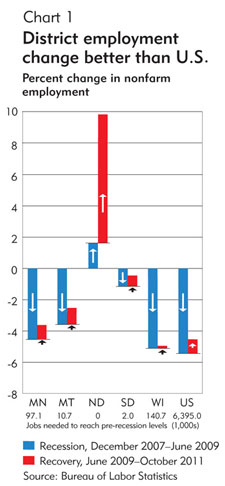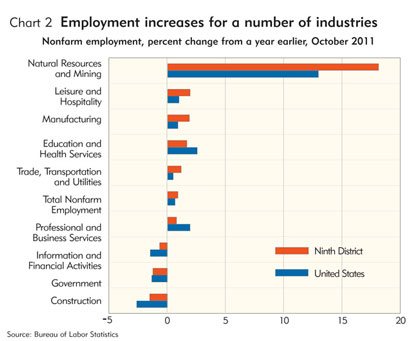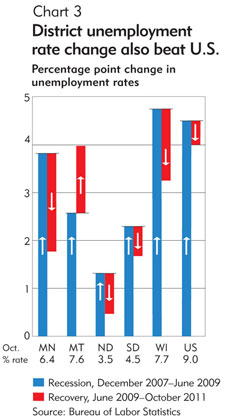The Ninth District economy is expected to grow moderately in 2012, according to the Minneapolis Fed’s forecasting models and outlook surveys. A number of favorable signs in the district economy are tempered by the headwinds of a slow housing construction market and uncertainty regarding the sovereign debt crisis in Europe. The district enjoys strong agriculture, mining and oil industries, healthy manufacturing exports and moderate consumer spending growth with subdued price increases. While the Minneapolis Fed’s forecasting model suggests that employment growth will accelerate in 2012, surveyed business leaders noted that their optimism is mixed with caution.
Positive signs
The list of positive signs begins with the district’s natural resource industries, particularly agriculture, mining and oil drilling. While agriculture production levels were down from 2010 levels, income during 2011 was buoyed by strong crop and livestock prices. In mining, iron ore production and shipments in Minnesota and Michigan during the first eight months of 2011 were 14 percent and 5 percent higher, respectively, than a year earlier.
Meanwhile, oil drilling in western North Dakota is moving at a frantic pace. The number of active oil rigs in November reached 187, up from 139 a year earlier. Only Texas and Oklahoma have more active oil rigs than North Dakota. Oil drilling continues to bring jobs and income to North Dakota. Not surprisingly, North Dakota business leaders posted the most optimistic reply to the business outlook poll regarding their outlook for their local economies, with 91 percent somewhat or very optimistic, compared with 62 percent districtwide.
The district’s manufacturing sector continues to expand. Since the start of the recovery in June 2009, Creighton University’s Business Conditions Index has generally shown manufacturing growth in Minnesota and the Dakotas. Since last spring, growth has decelerated somewhat in Minnesota and South Dakota, while growth has accelerated in recent months in North Dakota.
The manufacturing sector has been buoyed by growth in exports. Through October, district manufactured exports have increased 11 percent compared with a year earlier, ranging from a 6 percent increase in Montana to a 22 percent gain in South Dakota. As long as economic conditions abroad remain favorable, district manufacturers will benefit from solid export activity. Respondents to the manufacturing business conditions survey expect orders, production, employment, investment and exports to increase in 2012, but they are less sanguine about profitability.
Consumers are opening their purses, although cautiously. Nationally, retail sales increased 0.2 percent from October to November, after two solid months of increases. The district outlook for the holiday spending season is positive. For example, according to the University of St. Thomas Holiday Spending Sentiment Survey, Minneapolis-St. Paul households were predicted to spend 3.4 percent more on holiday gifts than they did in 2010. Respondents to the business outlook poll are somewhat optimistic for consumer spending in their communities during 2012.
Meanwhile, consumers are facing relatively tame price increases. The Consumer Price Index decreased slightly from September to November. While the year-over-year rate was up 3.4 percent in November, the core inflation rate, which excludes relatively volatile food and energy prices, was up 2.2 percent compared with a year earlier.
Recent changes in gasoline prices have been tipping downward, giving consumers more cash to spend on other goods and services. In Minnesota, average gasoline prices dropped below $3.20 per gallon in December, down from almost $4 per gallon in the spring and just 25 cents per gallon higher than a year earlier.
The Minneapolis Fed’s forecasting models predict that personal income will grow in 2012 at rates somewhat similar to 2011 rates, another positive sign for consumer spending. However, shoppers could see some price increases in 2012, as more respondents to the manufacturing survey and business outlook poll expect to increase prices than decrease prices for their products and services in 2012.
Headwinds continue to blow
Despite positive signs in the economy, business leaders noted caution regarding prospects for 2012. The home building sector continues to move slowly. District housing units authorized through October were down 4 percent compared with the same period a year earlier. Authorization levels are only about one-third of their prerecession peak levels.
However, double-digit gains in existing home sales during the third quarter compared with a year earlier were posted by all district states, a sign that residential real estate markets are recovering. While average home prices continue to drop, decreases have slowed in recent quarters. Prices for existing home sales in district cities where data are available were modestly lower than a year earlier, including Minneapolis-St. Paul and Fargo, N.D. (−6.5 percent), Sioux Falls, S.D. (−2.0 percent) and Bismarck, N.D. (−1.1 percent). Falling house prices have lowered consumer wealth and, consequently, consumer spending.
In 2012, housing units authorized are expected to grow in Montana and South Dakota, remain level in North Dakota and decrease in Minnesota and Wisconsin, according to the Minneapolis Fed’s forecasting model. Meanwhile, respondents to the business outlook poll are generally pessimistic about housing starts in their communities, although their responses are more positive than in 2010.
Another economic headwind blows from across the Atlantic. Difficulties facing European governments and banks regarding sovereign debt levels have created uncertainty in U.S. markets. Should the situation lead to a European recession, the fallout would have an adverse impact on district financial markets and exporters and dampen economic activity.
District employment outperforming the nation
District employment growth and the unemployment rate have outperformed the nation since the start of the recovery in June 2009. Nonfarm employment has grown in district states since June 2009 (see Chart 1); only Wisconsin lags the nation in its return to employment levels prior to the recession.
Aside from North Dakota, which recorded employment gains during both the recession and the recovery, other district states need some gains in order to return to prerecession employment levels, ranging from 2,000 jobs in South Dakota to 140,700 jobs in Wisconsin. According the Minneapolis Fed’s forecasting models, South Dakota and Montana will reach prerecession employment levels during 2012, Minnesota by first quarter 2013 and Wisconsin by first quarter 2014.
From October 2010 to October 2011, nonfarm employment grew 0.8 percent in the district, slightly faster than in the nation. Natural resources and mining jobs grew the fastest (18.1 percent), followed by leisure and hospitality (2 percent) and manufacturing (1.9 percent). Job losses were recorded by construction (−1.3 percent), government (−1.1 percent) and information and financial activities (−0.5 percent) (see Chart 2).
While job growth has increased moderately, unemployment rates have edged downward. During the recession and recovery, unemployment rate changes in district states have been more favorable than in the nation (see Chart 3). As of October, unemployment rates were lower than U.S. rates in all areas of the district except the Upper Peninsula of Michigan, where the rate was still above 11 percent.
The Minneapolis Fed’s forecasting models are relatively optimistic for 2012. Nonfarm employment is expected to grow faster during 2012 than 2011 in all areas of the district and at rates that exceed historical averages. Meanwhile, unemployment rates are expected to decrease moderately in all areas, but stay above historical averages, except in North Dakota, where the rate is predicted to remain below its historical average.
Agriculture strong despite difficult growing season
For many district agricultural producers, 2011 was a wild ride. A wet, cold spring delayed planting, and flooding destroyed crops in parts of the district, while severe summer heat put stress on wheat and livestock producers. Fortunately, the harvest season was very dry, which allowed farmers to get into and out of the fields quickly. That dryness gave way to drought conditions in some areas of the district, notably southern Minnesota, a trend which producers hope will reverse by next spring. Another bright spot was very strong output prices that made up for reduced yields in many areas. There are optimistic expectations for newly purchased capital equipment and expected higher prices for outputs in 2012.
In 2011, both farmers and ranchers saw big increases in prices for their products from their already strong 2010 levels (see table). But the district saw big production decreases for many crops, including soybeans (down 12 percent), wheat (down 29 percent) and sugar beets (down 20 percent) compared with 2010, while corn output is expected to be roughly even with 2010’s strong harvest. Meanwhile, ethanol prices and production trended upward during 2011. While prices for several farm inputs increased during 2011, including fertilizer, chemicals and diesel fuel, these prices were offset by gains in crop prices.
According to the Minneapolis Fed’s third-quarter (October 2011) agricultural credit conditions survey, 2011 was a strong year for agricultural income, with 92 percent of respondents reporting increased or steady income, which follows several quarters of increases. Household spending and capital investment also increased. Agricultural lenders are somewhat optimistic for farm profits in the final quarter of 2011, with 54 percent expecting increased income and only 15 percent expecting decreased income.
Like farmers, animal producers enjoyed rising prices (see table). Building on 2010’s large increases, prices surged further for hogs (20 percent), milk (23 percent) and steers (20 percent). These output price gains more than offset higher feed costs faced by meat and dairy producers.
The outlook for 2012 is upbeat, as agricultural producers invest their profits. In addition to positive returns on investment, output prices are expected to rise. According to U.S. Department of Agriculture forecasts, 2012 prices for corn, soybeans, wheat, steers and hogs are expected to increase.
| Crop and meat prices expected to increase in 2012 Average farm prices |
||||
|---|---|---|---|---|
| 2008/ 2009 |
2009/ 2010 |
Estimated 20010/2011 | Projected 2011/2012 | |
| (Current $ per bushel) | ||||
| Corn |
4.06
|
3.55
|
5.18
|
5.90-6.90
|
| Soybean |
9.97
|
9.59
|
11.30
|
10.7-12.70
|
| Wheat |
6.78
|
4.87
|
5.70
|
7.05-7.55
|
2009 |
2010 |
Estimated 2011
|
Projected
2012 |
|
| (Current $ per cwt) | ||||
| All Milk |
12.83
|
16.29
|
20.10-20.20
|
18.10-18.90
|
| Choice Steers |
83.25
|
95.38
|
114.85
|
120-128
|
| Barrows & Gilts |
41.24
|
55.06
|
66.32
|
63.00-68.00
|
|
Source: |
||||
Joe Mahon is a Minneapolis Fed regional outreach director. Joe’s primary responsibilities involve tracking several sectors of the Ninth District economy, including agriculture, manufacturing, energy, and mining.









